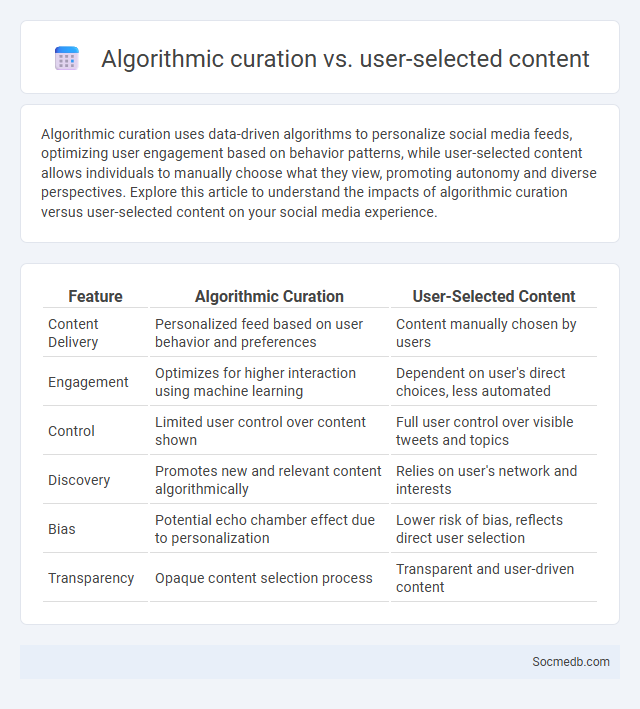
Photo illustration: Algorithmic curation vs User-selected content
Algorithmic curation uses data-driven algorithms to personalize social media feeds, optimizing user engagement based on behavior patterns, while user-selected content allows individuals to manually choose what they view, promoting autonomy and diverse perspectives. Explore this article to understand the impacts of algorithmic curation versus user-selected content on your social media experience.
Table of Comparison
| Feature | Algorithmic Curation | User-Selected Content |
|---|---|---|
| Content Delivery | Personalized feed based on user behavior and preferences | Content manually chosen by users |
| Engagement | Optimizes for higher interaction using machine learning | Dependent on user's direct choices, less automated |
| Control | Limited user control over content shown | Full user control over visible tweets and topics |
| Discovery | Promotes new and relevant content algorithmically | Relies on user's network and interests |
| Bias | Potential echo chamber effect due to personalization | Lower risk of bias, reflects direct user selection |
| Transparency | Opaque content selection process | Transparent and user-driven content |
Understanding Algorithmic Curation: Definition and Mechanisms
Algorithmic curation on social media refers to the automated process by which platforms like Facebook, Instagram, and TikTok select and prioritize content tailored to individual user preferences based on data signals such as engagement history, content type, and user behavior. These algorithms utilize machine learning models to analyze vast amounts of user interaction data, including likes, shares, comments, and watch time, to predict and deliver content that maximizes user retention and satisfaction. The mechanisms involve ranking, filtering, and recommending posts through personalized feeds, influencing user experience and shaping information exposure across networks.
User-Selected Content: Empowering Personal Choice
User-selected content on social media platforms enhances personal agency by allowing individuals to tailor their information feeds according to preferences, interests, and values. Algorithms supporting customized content curation optimize user engagement by prioritizing relevant posts, videos, and articles. Empowering personal choice in content consumption also fosters diverse perspectives and reduces exposure to irrelevant or unwanted material.
Algorithmic Timelines: How They Structure Information Flow
Algorithmic timelines prioritize content based on relevance, user engagement, and past interactions to curate a personalized feed tailored for Your interests. These algorithms analyze factors such as post popularity, recency, and user behavior to structure information flow, ensuring you see the most pertinent updates first. By filtering vast amounts of data, algorithmic timelines shape the visibility of posts, influencing what content gains attention and drives online conversations.
Comparing User Engagement in Curated vs. User-Selected Feeds
User engagement varies significantly between curated and user-selected social media feeds, with curated feeds often delivering content optimized through algorithms that increase interaction rates by up to 30%. User-selected feeds provide personalized choice, leading to higher satisfaction but sometimes lower overall engagement due to less content diversity. Analyzing metrics such as average session duration, click-through rates, and content sharing reveals that algorithm-driven curation enhances immediate engagement, while user-selected feeds foster longer-term platform loyalty.
The Role of Personalization in Algorithmic Content Delivery
Personalization in algorithmic content delivery enhances user engagement by tailoring social media feeds to individual preferences, behaviors, and interactions. Advanced machine learning models analyze vast datasets to predict content relevance, increasing the chances of user retention and satisfaction. Effective personalization balances content diversity with user interests, promoting meaningful interactions while minimizing echo chambers.
Pros and Cons of Algorithmic Curation
Algorithmic curation on social media personalizes your content feed by analyzing your preferences, increasing engagement and relevance. However, it can also create echo chambers, limiting exposure to diverse perspectives and reinforcing biases. Balancing curated content with conscious exploration helps maintain a more informed and varied online experience.
Advantages and Limitations of User-Selected Content
User-selected content on social media empowers you to tailor your feed according to personal interests, enhancing engagement and relevance. This customization boosts user satisfaction but may also create echo chambers, limiting exposure to diverse perspectives and potentially reinforcing biases. Balancing content control with algorithmic diversity is essential for a well-rounded social media experience.
Impact on Information Diversity: Algorithms vs. User Choice
Social media platforms heavily rely on algorithms designed to personalize content, which often narrows the diversity of information by reinforcing users' existing preferences and beliefs. In contrast, when users actively choose varied sources and viewpoints, they experience a broader spectrum of information, fostering critical thinking and reducing echo chambers. Balancing algorithm-driven recommendations with user-driven exploration is essential to enhance information diversity and promote a well-informed public.
Ethical Considerations in Automated vs. Manual Content Selection
Automated content selection on social media relies on algorithms that prioritize engagement metrics, potentially amplifying biased or harmful content without human judgment to mitigate ethical issues. Manual content selection involves human moderators who can apply context-sensitive decisions to uphold community standards and ethical guidelines effectively. You must balance automation efficiency with ethical responsibility to maintain trust and promote a safe online environment.
Future Trends: Balancing Algorithmic and User-Driven Content
Future social media trends emphasize a dynamic balance between algorithmic curation and user-driven content to enhance engagement and authenticity. Advances in artificial intelligence will enable algorithms to better understand user preferences while incorporating more user control to prevent echo chambers and promote diverse perspectives. Platforms investing in hybrid models that blend machine learning with community input will shape the next generation of social interaction and content discovery.
 socmedb.com
socmedb.com